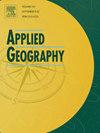Carbon emissions and government interventions in urban agglomerations of China: An integrated GWR and neural network approach
IF 4
2区 地球科学
Q1 GEOGRAPHY
引用次数: 0
Abstract
The dual-carbon target that aims to achieve peak carbon and carbon neutrality before 2060 is a pivotal strategy for China's green and low-carbon development. As major contributors to China's economy and its carbon emissions, urban agglomerations play a critical role in reducing carbon emissions, and government interventions have attracted considerable attention. In this context, this study focuses on the spatiotemporal nonstationary characteristics of factors influencing carbon emissions in 19 urban agglomerations in China. Using the geographically weighted regression (GWR) model and its extensions, we analyzed the impacts of two government intervention factors—fiscal expenditure and green cover—on carbon emissions. A comparison of multiple models revealed that the geographically and temporally neural network weighted regression (GTNNWR) model best captures the spatiotemporal nonstationary relationships. Our findings indicate that increased government fiscal expenditure generally reduces carbon emissions, with stronger effects in the northern cities we studied. Urban green cover has significant negative impacts in the core cities of most urban agglomerations. However, these impacts may reverse in a very small portion of cities, possibly due to differences in development stages. The results provide insights for the government to formulate carbon reduction strategies.
中国城市群碳排放与政府干预:基于GWR和神经网络的综合分析
2060年前实现碳峰值和碳中和的“双碳目标”是中国绿色低碳发展的关键战略。作为中国经济和碳排放的主要贡献者,城市群在减少碳排放方面发挥着至关重要的作用,政府干预受到了广泛关注。在此背景下,本研究重点分析了中国19个城市群碳排放影响因素的时空非平稳特征。利用地理加权回归(GWR)模型及其扩展,分析了财政支出和绿色覆盖两个政府干预因素对碳排放的影响。多个模型的比较表明,地理和时间神经网络加权回归(GTNNWR)模型最能反映时空非平稳关系。我们的研究结果表明,政府财政支出的增加总体上减少了碳排放,在我们研究的北方城市中效果更强。在大多数城市群的核心城市,城市绿化覆盖具有显著的负向影响。然而,可能由于发展阶段的差异,这些影响在极少数城市可能会发生逆转。研究结果为政府制定碳减排战略提供了参考。
本文章由计算机程序翻译,如有差异,请以英文原文为准。
求助全文
约1分钟内获得全文
求助全文
来源期刊

Applied Geography
GEOGRAPHY-
CiteScore
8.00
自引率
2.00%
发文量
134
期刊介绍:
Applied Geography is a journal devoted to the publication of research which utilizes geographic approaches (human, physical, nature-society and GIScience) to resolve human problems that have a spatial dimension. These problems may be related to the assessment, management and allocation of the world physical and/or human resources. The underlying rationale of the journal is that only through a clear understanding of the relevant societal, physical, and coupled natural-humans systems can we resolve such problems. Papers are invited on any theme involving the application of geographical theory and methodology in the resolution of human problems.
 求助内容:
求助内容: 应助结果提醒方式:
应助结果提醒方式:


